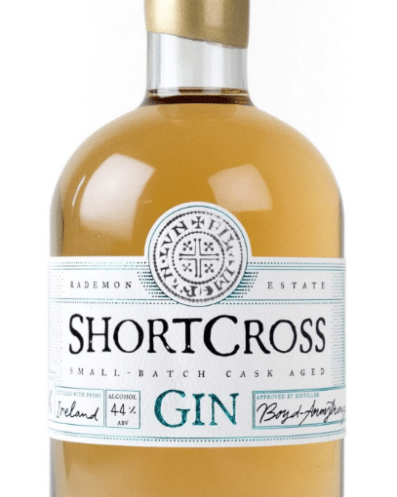Shortcross Small Batch Cask Aged starts with Rademon Estate Distillery’s flagship gin, and rests it for four month in European Oak barrels from a Bordeaux Wine estate. The barrel aged gin is the first flirtation with barrels for the young distillery, who just barreled their first batch of whiskey, and which is still some years off…
Tasting Notes
Absolutely gorgeous nose! Herbal, but more towards the floral side of that genre, a veil of clover, vanillin and barrel notes, herbaceous juniper, grassy meadow notes, toasted walnut and burnt orange rinds. It’s all blended quite delicately, with the wood only subtly in the mix, transforming the botanicals and not shouting or being too literal. It smells perfectly balanced.
You do get a crisp hit of wood early on the palate of Shortcross Small Batch Cask Aged, with lots of green, garden-notes. It strikes me as being clover green, yarrow, maple leaf, with juniper and astringent, resiny pine, especially towards the finish. Faint oak, dry wood chip and a hint of cranberry. The finish seems to suddenly flip upwards, as the dryness takes the wood character. Warm fumes with hints of wood endure on a palate that gets drier and drier.
Cocktails
As a sipping gin, I’m not sure Shortcross Small Batch Cask Aged works as well as it does mixed. I like it in a Negroni, and think that with Tonic (this seems to be an emerging way people are drinking their aged gin I’ve been told; therefore, I’m going to be giving it a closer look as a drink option when I do my aged gin reviews) it actually works. The green notes definitely carry over, and dare I say, it works while being quite unexpected for an aged gin.
Overall
In the bigger picture I’d characterize Shortcross Small Batch Cask Aged as being squarely within this trend in the last eighteen months where aged gin has stepped out of the shadows and distillers are finally getting it right. Really right.
I’d love a bit more vanillin and a bit more barrel, and less wood on the finish. I love the botanical expression but it feels like it could use a hint more anise or cinnamon to balance things out. But I think therein comes the risk of bottling a gin designed to be an unaged spirit. The design process for an aged spirit needs to be different because botanicals and flavor profiles change. Just as a good bourbon doesn’t necessarily make a good white whiskey, a good gin doesn’t always get better in the barrel. It’s good, but it’s missing something. It’s almost there. But worth a look if you can get your hands on one of the 460. If not, stay tuned for the next one.

